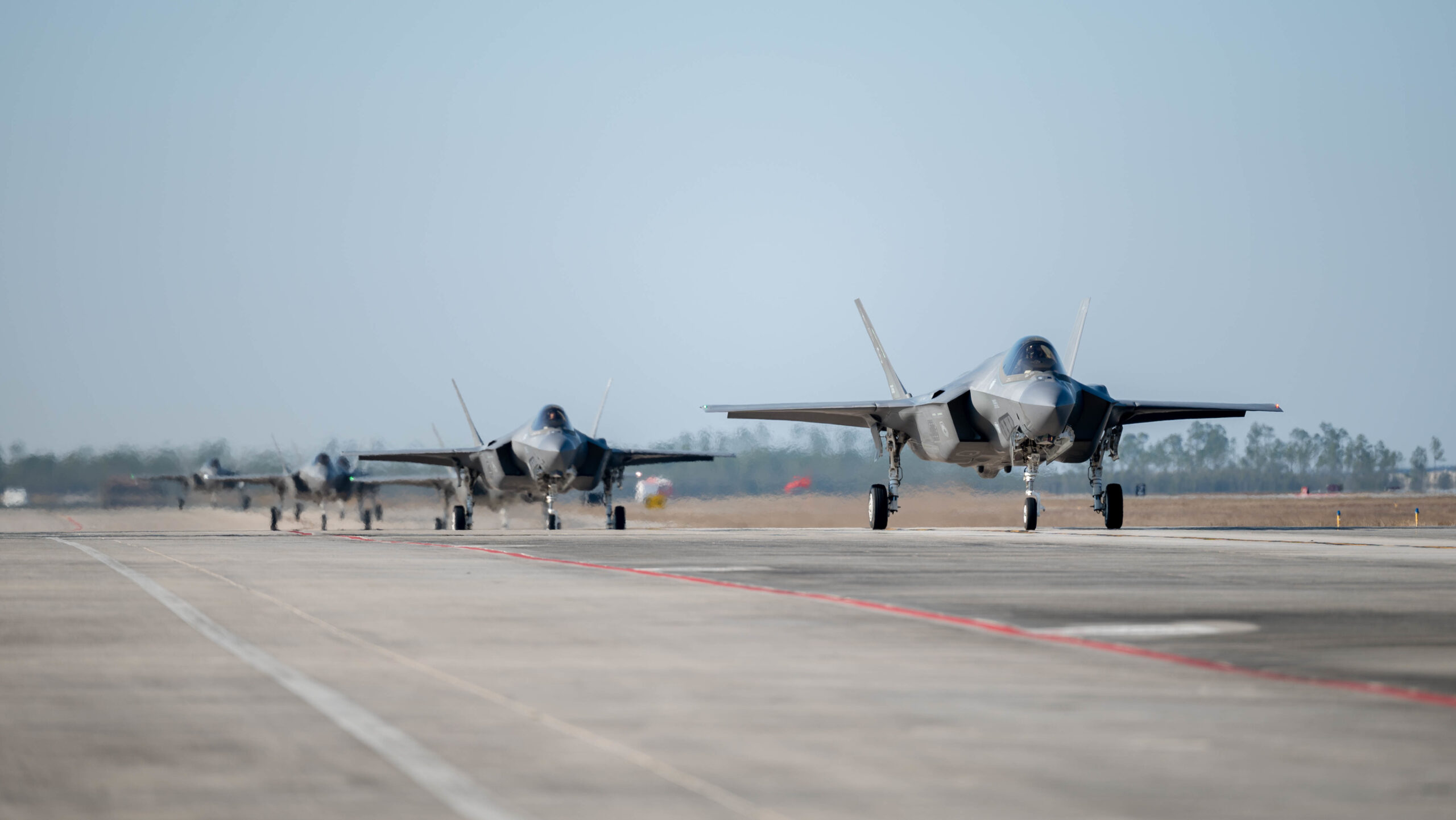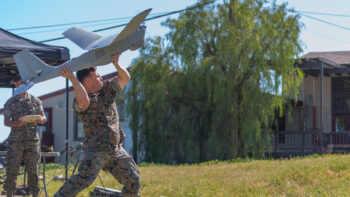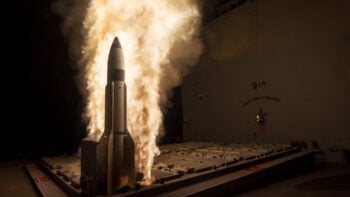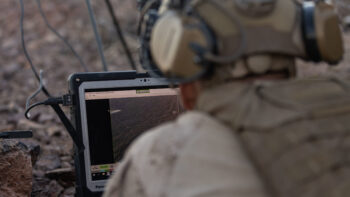
F-35A Lightning IIs assigned to the 308th Fighter Squadron, Luke Air Force Base, Arizona, taxi the flight line at Tyndall AFB, Florida, Jan. 27, 2022. (U.S. Air Force/Anabel Del Valle)
Updated 7/29/22 at 2:36 pm ET with further information from the Air Force and at 4:49 pm ET with information from the F-35 Joint Program Office.
WASHINGTON: The Air Force is grounding the majority of its F-35 Joint Strike Fighter fleet today, due to a faulty component inside its ejection seat that could prevent the pilot from being able to safely egress from the aircraft during an emergency, Breaking Defense has learned.
In response to an inquiry, Air Combat Command spokeswoman Alexi Worley confirmed the temporary standdown of ACC-controlled F-35s.
“ACC’s F-35s do have Martin-Baker ejection seats, and on July 19, began a Time Compliance Technical Directive to inspect all of the cartridges on the ejection seat within 90 days,” she stated. “Out of an abundance of caution, ACC units will execute a stand-down on July 29 to expedite the inspection process. Based on data gathered from those inspections, ACC will make a determination to resume operations.”
Later on Friday afternoon, Air Education and Training Command announced it had also paused F-35 operations on July 29 “to allow our logistics team to further analyze the issue and expedite the inspection process,” said AETC spokeswoman Capt. Lauren Woods. AETC controls F-35 training squadrons at Luke Air Force Base, Arizona, and Eglin AFB in Fla.
“Based on the results of these inspections and in conjunction with ACC, the lead command for F-35, AETC will make a decision regarding continued operations,” Woods said.
While ACC controls the majority of operational USAF F-35s, smaller numbers of jets are spread out among other major commands, including United States Air Forces in Europe (USAFE) and Pacific Air Forces (PACAF). It was not immediately clear if those units would also be standing down their fifth-generation fighters for a safety check.
At issue are cartridge actuated devices — explosive cartridges used inside ejection seats to help propel the seat out of an aircraft during an emergency. According to the Air Force, certain production lots of CADs used in Martin-Baker ejection seats have been identified by the company as being defective and needing replacement.
“Since CADs are used in the ejection process, a faulty CAD may not allow all the functions necessary to take place that would allow a complete and safe ejection,” Michael Cisek, a senior associate at the aviation consulting firm AeroDynamic Advisory, told Breaking Defense on Wednesday. “While the aircraft are flyable, I don’t think too many pilots would be willing to fly knowing they may not be able [to] eject.”
This latest news comes days after the Air Force’s Air Education and Training Command stated that it had temporarily grounded almost 300 training aircraft due to the CAD-supply issue, and the Navy separately acknowledged that it had grounded an unspecified number of its own trainers and combat aircraft.
Breaking Defense first reported the Navy groundings on Wednesday and Air Force Times first reported the Air Force groundings on Thursday.
The problems have left the US Navy and Air Force scrambling to understand the scope of the problem, which has also impacted the United Kingdom’s Eurofighter Typhoons and Red Arrow demonstration team, according to the Daily Express.
The Navy’s Naval Surface Warfare Center Indian Head Division (NSWC IHD) supplies CADs and Propellant Actuated Devices for the entirety of the joint force, including the Army, Air Force, Navy and Marine Corps aircraft.
According to Naval Air Systems Command, the Navy was notified of a potential defect by Martin-Baker and began using “validated radiography procedures” to scan its available CAD inventory and verify that it was “properly manufactured.” NSWC IHD then began shipping cleared replacement parts on July 24 “to several fleet maintenance centers,” the NAVAIR news release stated.
The F-35 Joint Program Office has issued a “90-day Time Compliance Technical Directive (TCTD) inspection procedure” that F-35s will go through to be checked for defective CAD, the program office said in response to questions from Breaking Defense. International F-35 customers have also been made aware of CAD issue.
“The collective team is actively engaged in supporting the inspection process, providing supply as needed, and communicating with stakeholders,” the JPO stated.
A Temporary Standdown of Air Force Trainers
The Air Force initiated a standdown on July 27 so that maintainers could inspect the 203 T-38 and 76 T-6 aircraft suspected of being equipped with the defective CAD, Air Force spokeswoman Aryn Lockhart said in a statement. That number represents 40% of AETC’s T-38 fleet and 15% of its T-6 fleet, including trainers at the undergraduate pilot training bases and Naval Air Station Pensacola.
Once maintainers confirm the ejection seats are fully functional, those specific aircraft will return to service, with flying operations for unaffected aircraft expected to resume on July 28, Lockhart said.
However, Maj. Gen. Craig Wills, 19th Air Force Commander, emphasized that aircraft will not begin flying unless the service is “confident” its ejection seats are in proper working order.
“Our primary concern is the safety of our airmen and it is imperative that they have confidence in our equipment,” he said in a statement. “Our actions today were taken out of an abundance of caution in order to ensure the safety of our pilots and aircrew.”
Although Air Combat Command also operates T-38s, it flies the A and B models that do not have Martin-Baker ejection seats. Therefore, they are not impacted by the stand down, Worley said.
An Unknown Number of Navy Aircraft Affected
On Wednesday, a Naval Air Systems Command spokeswoman said the service “has made the decision to ground some fixed-wing aircraft due to an ejection seat cartridge actuated device (CAD) production issue.”
The spokeswoman declined to comment on how many aircraft were ultimately affected by the problem for “operational security” reasons, but the initial press release on the issue said the defective CAD was isolated to a “limited range of lot numbers” used in F/A-18B/C/D Hornets, F/A-18E/F Super Hornets, E/A-18G Growlers, and T-45 Goshawk and F-5 Tiger II training aircraft.
In light of the Air Force’s public disclosure of the number of T-38 and T-6 aircraft that were grounded, Breaking Defense sought more information from the Navy about the number of aircraft it grounded. A service spokeswoman again declined to provide any specific information, saying the Air Force disclosed numbers of training aircraft, rather than those operational or deployed forward.
“Disclosing the number of total aircraft (with or without specifying Type/Model/Series) poses an OPSEC risk,” the spokeswoman told Breaking Defense on Thursday. “At any given time, we will have an undisclosed number of aircraft being serviced, but stating the total number of aircraft affected by this issue effectively alerts our adversaries to limitations in our ability to respond should the need arise.”
While the Hornets, Super Hornets and Growlers do remain operational in deployed squadrons, the T-45s are primarily used for training Navy pilots. Meanwhile, the service bought nearly two dozen F-5s in fiscal 2020 to “provide air-to-air training for strike fighter and electronic warfare advanced readiness programs, large force exercise, unit-level training and fleet replacement squadron training,” according to budget justification documents.
Marines new ‘Fusion Center’ aimed transitioning cutting edge tech more smoothly
Marine Corps officials said the new office will act as a bridge over the Pentagon’s infamous “valley of death” and will first focus on counter-drone systems.


























